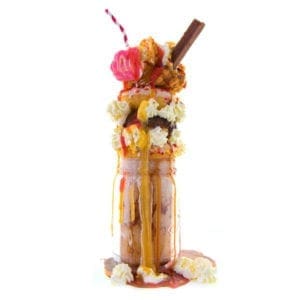Part 1 and Part 2 of international food and restaurant consultants Baum+Whiteman’s view of the hottest F&B trends for 2017 covered a wide range of culinary angles. Here is the third and final installment of the predictions for next year, along with some ‘buzzwords’ that you’re sure to be hearing more of in restaurant kitchens in the coming months.

10. Restaurants surrounded by wolves
We pointed out last year that it’s tough for restaurants when other retailers – department stores, drug stores, meal kits purveyors, supermarkets, upscale clothing boutiques – continually poach customers.
Now, adding insult to injury, restaurants find themselves competing with their own suppliers. We have Kellogg’s opening a cereal restaurant in the middle of Times Square; Chobani yogurt with a branded storefront cafe and another in a new Target store; and Pepsi’s got a 5000 sq.ft. highly promoted kola-nutcentric restaurant/event space near New York’s tourist-ridden Chelsea Market. Boars Head licensed its name and logo to a new deli in downtown Chicago and more such branded restaurants are in the works. These companies’ common objective? To project their brands beyond places you’d normally find them and to make longer-lasting impressions. After all, how much impact can a box of cereal expect sitting on food stores’ shelves, particularly when increasing numbers of online shoppers never see the shelf? So they’re planting flags where the people are without worrying about competing with their restaurant customers. Nespresso seems to do this superbly.
There’s even greater impact on the industry when non-food brands sneak into the restaurant business and dilute the market. For example: Moleskin now has a two-story cafe in Milan (see photo) serving breakfast, lunch and brunch while letting customers try out their products, and they expect to expand.
Also, Guess Corporation is launching Guess Bread Company on sites with its GP Express convenience stores; they’ll be 20-table ventures with open kitchens. There are Martha Stewart Cafes going into Macy’s stores, and this Thanksgiving you can buy Martha’s meal kit by mail, perhaps diverting some families from dining out to dining in. Washington’s District Hardware and Bike will open a 6,300-square-foot location with a cafe serving coffee, light food, beer and wine. There’s a cafe in Samsung’s immersive retail extravaganza in New York.
A Thousand Cuts: Here’s the thing … a restaurant can’t (for example) incorporate an Armani boutique, but many Armani boutiques have restaurants. Whole Foods incorporates branded restaurants in its stores, but restaurants can’t logically add a Whole Foods retail department. Conde Nast (Vogue, Vanity Fair, GQ) operates restaurants and bars overseas but restaurants can’t retaliate by adding magazine racks. A diner in Times Square won’t stop selling Kellogg’s cereals, and a mom-and-pop deli in The Loop won’t eject its Boars Head products, even though they’re near a branded competitor. Convenience stores move heavily into upscale prepared food, but restaurants can’t compete on price (or even speed) by selling C-store products. A Kith sneaker emporium in Brooklyn (where else?) has a successful all-day successful breakfast bar in its window and another inside a Nike x Kith Shop. But could a restaurant sell sneakers?
So restaurants appear to have their customers picked off by packs of retail wolves.
 11. Ramping up the spice – and then offsetting it
11. Ramping up the spice – and then offsetting it
No question that pepperheads are demanding ever-increasing levels of spice. And the more different spices in a single dish, the better they like it. According to Innova Market Insights, use of cayenne pepper rose 47% in global product launches last year. Other trending spices: caraway (up 40%), saffron (up 31%), horseradish (up 29%) and turmeric (up 21%). Why haven’t they told us that horseradish leaves (right) are eminently edible?
We believe the components of “curry powder” – which is not a spice but a blend – will be trending upward. And we don’t mean just Indian curry, because lots of curries in Southeast Asia are even more vibrant. So we’re looking at chilies, tamarind, lemongrass, turmeric, ginger, coriander/cilantro, cardamom, kaffir lime, cumin, cinnamon, cloves, caraway, mustard seed, shrimp paste, sharp citrus juices and zests – not all at once, but a few at a time, sometimes with barely detectable drops of soy sauce. The idea is not to produce something tasting like “curry sauce”, but instead (to use a musical analogy) play a few flavor notes without the entire chord.
Many of these spices are showing up in newly launched bottled beverages (see Trend #12, below) and in cocktails.
We seem to have crossed the fine line between pleasure and pain. But smart chefs are balancing the heat, often with sweetness. That’s why we’re seeing things like jalapeno honey and Nashville hot chicken with maple syrup. In fact, heat and sweet are what makes sriracha work. That’s why jerk watermelon (see Part 1) is such a winner.
And if you’re hoping pumpkin-spiced latte is passé, note that it is this season’s trendy hair color.
12. Where to look for innovation
Used to be thirty or forty years back, that changes in the way we eat emerged from the world of restaurants: chipotle peppers, sushi, pesto, carpaccio, lemongrass, foie gras, blackened redfish, and shiitake mushrooms all migrated from restaurants through food journalists to greengrocers’ and supermarkets’ shelves. It doesn’t seem that way now, particularly among corporate restaurants that seemed mired in a long moment of inertia and focused more on nuances between millennials and Gen Xers than on risky innovation.
Better than perusing a clutch of restaurant menus, you’ll now capture America’s hot new flavors in the packaged snacks and beverage aisles of the local supermarket. You’ll find dozens of products and startup brands, most of which you haven’t heard of – and most of which you won’t find in restaurants. Seen artichoke water, maple water or coconut water on a restaurant menu recently?
Creative energy in food has shifted away from what’s the next fast-cas restaurant or what’s the next hot vegetable, or what comes after molecular cuisine to young, fearless entrepreneurs making insect bars, seaweed noodles, vegetable yogurts, and bone broth pouches. There are people experimenting with pulses, fermented products, artisan superfoods and innovative beverages. Venture capital is raining on these visionaries because Big Food fumbled at innovation. The giants are too large to overcome corporate inertia. We’re getting the same feeling about restaurants, where the hottest recent “innovation” is all-day breakfast service.
One study showed that in 2015, the top five consumer packaged goods firms lost $13 billion in sales – much of that to food startups. But here’s how these lumbering giants may avoid the fate of dinosaurs: They’re forming their own venture capital arms, incubators and startup accelerators – General Mills, Kellogg’s, Campbell’s, Danone, Anheuser-Busch, Coca-Cola and other finest corporate minds of the 20th century. They’re seeking out small companies with fresh ideas and either financing, taking equity in them or buying them outright, hoping that’s where the next thing will emerge.
 13. Vegetables are the new comfort foods
13. Vegetables are the new comfort foods
A fascinating analysis of Pinterest’s users suggests that people are sifting the concept of comfort away from “emotional” dishes like mac-and-cheese to dishes that reflect more healthful considerations. The word “veggies” in Pinterest comfort food searches rose 336% in the last year, while lasagna, macaroni and stroganoff were off 69%, 55% and 50%.
We pointed out last year that pasta sales were taking a hit around the world, so perhaps here’s more evidence. The research also showed that consumers were ready to swap vegetables … spiralized or extruded zucchini or beets or carrots … for the real thing.
Consumers also are learning to swap mashed cauliflower for rice and pasta … and they’re doing it themselves or buying the stuff at growing numbers of food shops.
Some smart chef will figure out how to make an all- or mostly-vegetable crust for a healthier pizza. You read it here.
2017’s Buzzwords:
Horseradish
Radishes everywhere including fast-cas places
Celery
Newfangled, reinvented cottage cheese
Fake cheese options on regular menus
Matcha jumps the shark
Jackfruit
Upscale ramen noodle shops
War on waste: pickling vegetable flotsam that used to go into the trash to now become condiments, relishes and burger toppings
Clean label cold cuts
Cauliflower

French dip sandwiches for some reason … but if you want to take a leap, try the zesty Mexican version called torta ahogodo (photo, right)
Chefs playing around with aging meat in whisky, in sake lees, quick-aging with miso powder
Grain bowls
Breakfast transformed: more ethnic flavors, heavier brunch-type items
Verging on too many food halls, with negative impacts on mom-and-pops
Caccio e pepe on non-pasta dishes … as a steak sauce, on asparagus, brussels sprouts, spiralized vegetables
Robots in restaurants
Salted egg yolks
Asian bakeries
Some commercial stabs at 3-D food printing
Sophisticated soda
Everything’s going to become a snack
Missed Parts 1 and 2? Catch up on them by clicking: Hottest F&B trends in restaurant and hotel dining for 2017: Part 1 and Hottest F&B trends in restaurant and hotel dining for 2017: Part 2
About the source
Baum+Whiteman creates high-profile restaurants around the world for hotels, restaurant companies, museums and other consumer destinations. Based in New York, their projects include the late Windows on the World and the magical Rainbow Room, and the world’s first food courts. They also run F&B trends seminars for major hotel and restaurant companies. They currently are working in Dubai, New York and Florida. Contact: Michael Whiteman 718 622 0200 mw@baumwhiteman.com.







 11. Ramping up the spice – and then offsetting it
11. Ramping up the spice – and then offsetting it 13. Vegetables are the new comfort foods
13. Vegetables are the new comfort foods











